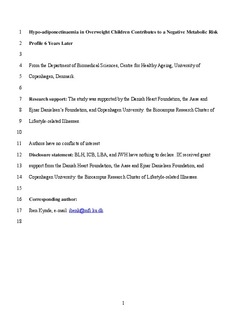| dc.contributor.author | Kynde, Iben | |
| dc.contributor.author | Heitmann, Berit L. | |
| dc.contributor.author | Bygbjerg, Ib C. | |
| dc.contributor.author | Andersen, Lars Bo | |
| dc.contributor.author | Helge, Jørn W. | |
| dc.date.accessioned | 2010-01-14T12:40:30Z | |
| dc.date.issued | 2009-08-27 | |
| dc.identifier | Seksjon for idrettsmedisinske fag / Department of Sports Medicine | |
| dc.identifier.citation | Metabolism: Clinical and Experimental. 2009, 58(12), 1817-1824 | en |
| dc.identifier.issn | 0026-0495 | |
| dc.identifier.uri | http://hdl.handle.net/11250/170857 | |
| dc.description | I Brage finner du siste tekst-versjon av artikkelen, og den kan inneholde ubetydelige forskjeller fra forlagets pdf-versjon. Forlagets pdf-versjon finner du på www.sciencedirect.com: http://dx.doi.org/10.1016/j.metabol.2009.06.014 / In Brage you'll find the final text version of the article, and it may contain insignificant differences from the journal's pdf version. The original publication is available at www.sciencedirect.com: http://dx.doi.org/10.1016/j.metabol.2009.06.014 | en |
| dc.description.abstract | Prognostic biomarkers are needed to identify children at increased cardiometabolic risk. The objective was to study whether markers of metabolism and inflammation, for example, circulating plasma adiponectin, leptin, interleukin-8, and hepatocyte growth factor, are associated with cardiometabolic risk factors in childhood and adolescence. This was a cross-sectional and prospective study, and the setting was the Danish part of the European Youth Heart Studies I and II. Participants were randomly selected girls and boys 8 to 10 years of age with complete baseline data (n = 256) and complete follow-up data 6 years later (n = 169). Cardiometabolic risk profile was calculated using a continuous composite score derived from summing of 6 factors standardized to the sample means (Z scores): body mass index, homeostasis model assessment of insulin resistance, total serum cholesterol to serum high-density lipoprotein cholesterol ratio, serum triglycerides, systolic blood pressure, and the reciprocal value of fitness (maximum watts per kilogram). Overweight was defined using international classification of body mass index cutoff points for children. Plasma adiponectin, leptin, interleukin-8, and hepatocyte growth factor were assessed using immunochemical assays. Linear relationships were found between metabolic risk score and both plasma adiponectin (inverse, P = .02) and plasma leptin (P b .0001) at baseline after adjustment for several confounders. In overweight but not normal-weight children, plasma adiponectin at baseline was inversely associated with metabolic risk score 6 years later (P = .04). In childhood, both hypoadiponectinemia and hyperleptinemia accompany a negative metabolic risk profile. In addition, circulating plasma adiponectin may be a useful biomarker to identify overweight children at greater future risk of the cardiometabolic adverse effects of overweight. | en |
| dc.format.extent | 213012 bytes | |
| dc.format.mimetype | application/pdf | |
| dc.language.iso | eng | en |
| dc.publisher | Elsevier | en |
| dc.subject | adiponectin deficiency | en |
| dc.subject | adolescent | en |
| dc.subject | blood pressure | en |
| dc.subject | body mass index | en |
| dc.subject | child | en |
| dc.subject | cytokines | en |
| dc.subject | Denmark | en |
| dc.subject | disease progression | en |
| dc.subject | female | en |
| dc.subject | hepatocyte growth factor | en |
| dc.subject | humans | en |
| dc.subject | insulin resistance | en |
| dc.subject | interleukin-8 | en |
| dc.subject | leptin | en |
| dc.subject | lipids | en |
| dc.subject | male | en |
| dc.subject | metabolic diseases | en |
| dc.subject | overweight | en |
| dc.subject | regression analysis | en |
| dc.subject | risk assessment | en |
| dc.subject | physiology | |
| dc.subject | metabolism | |
| dc.subject | epidemiology | |
| dc.subject | blood | |
| dc.title | Hypoadiponectinemia in overweight children contributes to a negative metabolic risk profile 6 years later | en |
| dc.type | Peer reviewed | en |
| dc.type | Journal article | en |
| dc.subject.nsi | VDP::Medical disciplines: 700 | en |
| dc.source.pagenumber | 1817-1824 | en |
| dc.source.volume | 58 | en |
| dc.source.journal | Metabolism: Clinical and Experimental | en |
| dc.source.issue | 12 | en |
